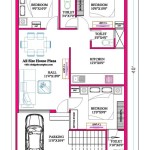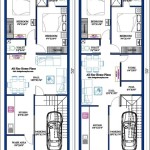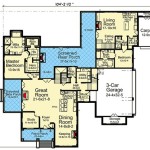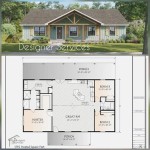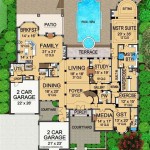Victorian Style House Floor Plans: A Deep Dive into Design and Functionality
Victorian architecture, a dominant style from roughly 1837 to 1901, encompasses a diverse range of sub-styles, each contributing unique characteristics to the floor plans of the era. Understanding Victorian house floor plans requires appreciating the societal norms, technological advancements, and aesthetic preferences that shaped these designs. This article delves into the key features, variations, and considerations associated with Victorian style house floor plans.
The Victorian era was a period of rapid industrialization and expansion, which significantly impacted housing. Middle-class families grew, and there was a newfound emphasis on displaying wealth and status through elaborate embellishments and spacious homes. This led to larger floor plans often exceeding the functional needs of a household and incorporating spaces dedicated to formal gatherings and social events.
Victorian floor plans are rarely open-concept designs. Instead, they emphasize distinct, separate rooms, each with a specific purpose. This separation reflects a desire for privacy and reflects the formal social etiquette of the time. Walls were not merely structural elements; they were boundaries defining distinct social environments within the home.
Key Features of Victorian Floor Plans
A defining characteristic of Victorian floor plans is their asymmetrical layout. Unlike the symmetrical facades of Georgian or Federal style homes, Victorian houses often feature irregular shapes, projecting bays, and towers, all contributing to a visually dynamic exterior and correspondingly complex interior floor plan.
The inclusion of numerous rooms is another central aspect. Victorian homes commonly featured a formal parlor or living room, a dining room, a library or study, a kitchen, and multiple bedrooms. Servants' quarters, often located on the upper floors or in a separate wing, were also a common feature in larger homes, reflecting the presence of domestic staff.
Hallways play a prominent role in Victorian floor plans, serving as circulation spines connecting the various rooms. These hallways were not merely conduits; they often featured elaborate ornamentation, such as intricate woodwork, stained glass windows, and decorative flooring. The hallway served as a formal introduction to the home's interior and a reflection of the homeowner's taste.
Staircases were another focal point of Victorian homes, often grand and ornate. They were strategically located, typically near the entrance, and served as a visual statement. The staircase design often incorporated carved balusters, elaborate newel posts, and decorative moldings.
The parlor, or living room, was the most formal space in the home, reserved for entertaining guests and displaying family heirlooms. It was typically located near the entrance and featured the finest furnishings and decorations. The dining room, also a formal space, was used for family meals and dinner parties. It was often located near the kitchen for ease of service.
The kitchen, while functional, was often relegated to the back of the house. It was considered a utilitarian space and was not typically designed for formal entertaining. However, the Victorian era saw advancements in kitchen technology, such as cast-iron stoves, which improved cooking efficiency.
Variations in Victorian Style and Their Impact on Floor Plans
The Victorian era encompasses various sub-styles, each influencing floor plan design. Queen Anne, perhaps the most recognizable Victorian style, is known for its asymmetrical facade, towers, turrets, and wrap-around porches. Queen Anne floor plans often feature complex layouts with multiple levels, bay windows, and intricate detailing.
Italianate style, inspired by Italian Renaissance architecture, is characterized by its symmetrical facade, low-pitched roof, and bracketed eaves. Italianate floor plans tend to be more regular and symmetrical than Queen Anne plans, with a central hallway and evenly distributed rooms.
Gothic Revival, drawing inspiration from medieval architecture, features pointed arches, steeply pitched roofs, and elaborate ornamentation. Gothic Revival floor plans often incorporate pointed archways, vaulted ceilings, and stained glass windows, creating a dramatic and imposing interior space.
Second Empire style, influenced by French Second Empire architecture, is distinguished by its mansard roof, dormer windows, and elaborate ornamentation. Second Empire floor plans often feature high ceilings, large windows, and formal rooms, reflecting the grandeur and opulence of the French style.
Stick Style, a transitional style between Gothic Revival and Queen Anne, emphasizes the structural elements of the building through exposed timbers and stickwork ornamentation. Stick Style floor plans often feature open floor plans with fewer interior walls and a more relaxed atmosphere than other Victorian styles.
Considerations When Interpreting and Adapting Victorian Floor Plans
When examining Victorian floor plans, it's crucial to consider the social hierarchy of the time. The presence of servants' quarters, for example, reflects the reliance on domestic staff. Understanding the intended use of each room is also essential for interpreting the floor plan effectively.
Adapting Victorian floor plans for modern living requires careful consideration. While retaining the historical character of the home is important, it may be necessary to modify the floor plan to meet contemporary needs. This may involve opening up walls to create larger, more open living spaces, or reconfiguring the kitchen to accommodate modern appliances and layouts.
Preserving historical details, such as original woodwork, stained glass windows, and decorative moldings, is crucial when renovating a Victorian home. These details contribute to the home's character and should be carefully preserved or restored. Replicating these details can be expensive, but it's worth the investment to maintain the home's historical integrity.
Consider the energy efficiency of Victorian homes. Many older homes lack adequate insulation and may have single-pane windows, leading to high energy bills. Upgrading the insulation and replacing the windows with energy-efficient models can significantly improve the home's energy performance without compromising its historical character.
Plumbing and electrical systems in Victorian homes may need to be updated to meet modern safety standards. Replacing outdated wiring and plumbing is essential for ensuring the safety and functionality of the home. This can be a complex and expensive undertaking, but it's a necessary investment for long-term safety and comfort.
Accessibility is another important consideration when adapting Victorian floor plans. Older homes may not be accessible to people with disabilities. Adding ramps, widening doorways, and installing elevators can improve accessibility without significantly altering the home's historical character.
Victorian floor plans offer a fascinating glimpse into the past, reflecting the social norms, technological advancements, and aesthetic preferences of the era. Understanding the key features, variations, and considerations associated with these floor plans is essential for appreciating the unique character and historical significance of Victorian homes.

Victorian Style House Plan 5 Beds Baths 4898 Sq Ft 320 414 Plans Floor Homes

Victorian Style House Plan 4 Beds 2 5 Baths 2174 Sq Ft 72 137 Houseplans Com

Victorian House Plans Decorative Painted Lady Home

House Plan 87609 Victorian Style With 5250 Sq Ft 4 Bed Bath

Victorian House Plans And Small Cottage Designs

Country Floor Plan 5 Bedrms Baths 4898 Sq Ft 146 2663

Victorian Style House Plan 5 Beds 6 Baths 4826 Sq Ft 72 196 Houseplans Com

Victorian Style House Design Timeless Appeal And Charm Bungalow Plans Floor

Merrimac 4333 4 Bedrooms And 3 Baths The House Designers

Victorian Style House Plan 5 Beds 3 Baths 3879 Sq Ft 72 891 Eplans Com

